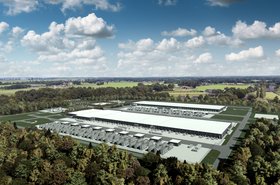To date, there has been a generally accepted consensus surrounding our network. We have cloud, colocation, enterprise, and Edge facilities, and each one fulfills its dutiful role dependent on client need. Competition is based around who can best meet requirements, and as a result, there are some companies that consistently top the podium.
But what if we rethought the entire structure of the network? What if we broke down the barriers, and intertwined all forms of IT infrastructure into one big network?
At the DCD>Connect London Event, we discussed this concept with Matt Hawkins, CEO of Cudo Ventures, a company looking to do just that.
“When we were running C4L, we were seeing hyperscalers, Amazon, Google, Alibaba, or the other providers taking the mass market share and having large global coverage, because they're the providers that can scale,” explained Hawkins.
“Then us being one of the secondary providers, and there are 1,000s of the secondary providers all around the world, they're typically only ever in one to a few data centers, maybe up to 10 or 20. But it makes it very hard to compete on a global scale from that perspective, and we were seeing this disparity of availability versus where the market was going.”
It was this frustration that led to Cudo Ventures exploring alternative solutions to make the market a little more equal-opportunity, and a little less dominated by the bigger companies that have been in control for years.
“We wanted to build a network where anyone can be a provider for that network. You can be a full Tier IV data center, or you could be a Tier I mini data center. You could just have set up some hardware in the back of your garage and you've got a load of computing capacity in there,” said Hawkins.
“The idea is that you can provide a global network so that everybody gets access to the infrastructure, and that infrastructure can be CPU, GPU, it can be bandwidth. We're even working with renewable energy mining farms. So it can be a renewable energy bitcoin mine. The idea is it's literally a global infrastructure network.”
So, should the hyperscalers be scared? Scared, probably not. Nervous? Maybe. There will always be a place for the big cloud providers, but for many, this counter data center network could offer a lot of solutions to their problems.
“Because you've got the ability to run in any location and on any hardware, you've kind of got the choice of the best economies in the world. If you want low bandwidth, then in different parts of Europe it can be ten times cheaper than in different parts of Asia. But then if you want a low cost of electricity, that could be in Sweden, or north Norway or other locations. So you get the best economies wherever the infrastructure is. From a buyer's perspective, it just gives you a big global network that you've got access to.
“So you might have 10,000 frames in a film, for example, and you need 10,000 graphics cards, or you need 10,000 servers. To do that, the only providers you can typically go to are the large hyperscalers. But now, you can go to our network, and then it distributes across the providers around the network. So from a supplier's perspective, they've all got a chance to compete in a global market, and from a buyer's perspective, it means you get the best economies of all these other providers around the world.”
Not only can your IT choices be customized to your needs, but you also needn’t sacrifice the standards and regulations you need to meet.
“On the platform, you can choose the regulated environment you want to run in. So in the UK, it might be ISO27001. In America, it might be SAS70. So you're still running in the same quality data centers that you would be if you just went to a single cloud provider,” said Hawkins.
“Or, if it's depersonalized data or things like weather analysis, where you don't actually care where that computer's running because the information isn't secure, and it's not relevant, then you can run across any hardware, which works out cheaper.
“To give you an idea, in comparison, the cost in some of the facilities to create a megawatt of infrastructure is as low as 100 to 150,000 USD per megawatt of capacity. Whereas you go to a normal data center, you might be paying one to three million USD per megawatt.”
With around a third of compute being batch parallel workloads that could run on this type of network, hyperscalers are not yet under threat. But for those who can, why wouldn’t you want a more efficient, cheaper, solution to your problems?
Find out more about Cudo Ventures distributed cloud network by watching the full DCD>Talk.





